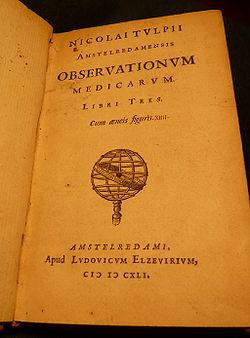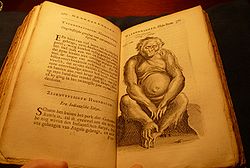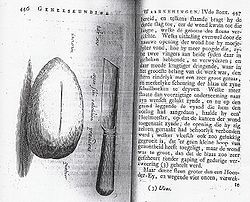
Observationes Medicae (Tulp)
Encyclopedia



Dutch people
The Dutch people are an ethnic group native to the Netherlands. They share a common culture and speak the Dutch language. Dutch people and their descendants are found in migrant communities worldwide, notably in Suriname, Chile, Brazil, Canada, Australia, South Africa, New Zealand, and the United...
doctors in the 16th and 17th centuries who wrote up their cases from private practise in Latin
Latin
Latin is an Italic language originally spoken in Latium and Ancient Rome. It, along with most European languages, is a descendant of the ancient Proto-Indo-European language. Although it is considered a dead language, a number of scholars and members of the Christian clergy speak it fluently, and...
to share with contemporary colleagues. This is therefore a common title, but this page is devoted to the 1641 book by Nicolaes Tulp
Nicolaes Tulp
Nicolaes Tulp was a Dutch surgeon and mayor of Amsterdam. Tulp was well known for his upstanding moral character.-Life:...
. Tulp is primarily famous today for his central role in the 1632 group portrait by Rembrandt of the Amsterdam Guild of Surgeons, which commemorates his appointment as praelector
Praelector
A praelector is a traditional role at the colleges of the University of Cambridge and the University of Oxford. The role differs between the two universities.At Cambridge, a praelector is a fellow of a college...
in 1628.
Professor Tulp
Though already well known at the time his book was written, Professor Tulp enjoyed international fame after publishing this book, and in 1652 a second edition was printed, highly unusual at that time. His book comprises 164 cases from his practise, kept in a diary from his early career onwards. His book was illustrated with plates, and it is not clear who drew these or engraved them. According to various sources, he drew many of these himself. His birth name was Claes Pietersz. He adopted the name Tulp when he had a Tulip shaped sign placed outside his door when he set up shop in Amsterdam. Many of his early patients could not read or write. He soon no longer needed to advertise his services, however, and his many duties as Praelector, and later, mayor of the city of AmsterdamAmsterdam
Amsterdam is the largest city and the capital of the Netherlands. The current position of Amsterdam as capital city of the Kingdom of the Netherlands is governed by the constitution of August 24, 1815 and its successors. Amsterdam has a population of 783,364 within city limits, an urban population...
, prevented him from spending so much time on his practise. He published the book 5 years after the Amsterdam Pharmacopoeia
Pharmacopoeia
Pharmacopoeia, pharmacopeia, or pharmacopoea, , in its modern technical sense, is a book containing directions for the identification of samples and the preparation of compound medicines, and published by the authority of a government or a medical or pharmaceutical society.In a broader sense it is...
was completed, which was his own personal initiative, and that helped to set intercity medical standards in the region known as the United Provinces
Dutch Republic
The Dutch Republic — officially known as the Republic of the Seven United Netherlands , the Republic of the United Netherlands, or the Republic of the Seven United Provinces — was a republic in Europe existing from 1581 to 1795, preceding the Batavian Republic and ultimately...
.
Vondel
Tulp had a reputation for a moral upstanding character, and Joost van den VondelJoost van den Vondel
Joost van den Vondel was a Dutch writer and playwright. He is considered the most prominent Dutch poet and playwright of the 17th century. His plays are the ones from that period that are still most frequently performed, and his epic Joannes de Boetgezant , on the life of John the Baptist, has...
wrote poetry extolling his virtue. He later also wrote a poem in honor of the second edition of this book.
Earliest illustration of a Chimpanzee
Tulp's book has various accounts of unusual illnesses and primarily growths or carcinomas, but also has accounts of creatures brought back from Dutch East India CompanyDutch East India Company
The Dutch East India Company was a chartered company established in 1602, when the States-General of the Netherlands granted it a 21-year monopoly to carry out colonial activities in Asia...
ships. His drawing of a Chimpanzee
Chimpanzee
Chimpanzee, sometimes colloquially chimp, is the common name for the two extant species of ape in the genus Pan. The Congo River forms the boundary between the native habitat of the two species:...
is considered the first of its kind. This creature was called an Indian Satyr, since all ships cargo was considered Indonesia
Indonesia
Indonesia , officially the Republic of Indonesia , is a country in Southeast Asia and Oceania. Indonesia is an archipelago comprising approximately 13,000 islands. It has 33 provinces with over 238 million people, and is the world's fourth most populous country. Indonesia is a republic, with an...
n. However, the accompanying text claims the animal came from Angola
Angola
Angola, officially the Republic of Angola , is a country in south-central Africa bordered by Namibia on the south, the Democratic Republic of the Congo on the north, and Zambia on the east; its west coast is on the Atlantic Ocean with Luanda as its capital city...
. This drawing was copied many times and formed the basis for many theories on the origin of man. Most notably, Tulp's work and that of Jacob de Bondt (alias Jacobus Bontius) was copied and republished by Linnaeus to show a link between apes and man.
Jan de Doot

Jan de Doot
Jan de Doot is the subject of a painting from 1655 by Carel van Savoyen. It shows de Doot, a smith, holding in one hand a kitchen knife, and in the other a large bladder stone the size and shape of an egg, set in gold. This 17th century Dutch blacksmith is said to have performed a successful...
performed a bladder operation on himself.
But this stone weighing 4 ounces and the size of a hen's egg was a wonder how it came out with the help of one hand, without the proper tools, and then from the patient himself, whose greatest help was courage and impatience embedded in a truly impenetrable faith which caused a brave deed as none other. So was he no less than those whose deeds are related in the old scriptures. Sometimes daring helps when reason doesn't.
Ludovicus Wolzogen
Observationes Medicae became so popular, that a hundred years later a translated version was published. Professor Tulp never wanted to publish in Dutch for fear of hypochondriac behavior. He was very against quackQuack
A quack is a person who pretends, professionally or publicly, to have skill, knowledge, or qualifications he or she does not possess.Quack may also refer to:* Quack , an independent-comics series published by Star Reach in the 1970s...
s and self-medication and it was for this reason that he worked on the Amsterdam Pharmacopoeia
Pharmacopoeia
Pharmacopoeia, pharmacopeia, or pharmacopoea, , in its modern technical sense, is a book containing directions for the identification of samples and the preparation of compound medicines, and published by the authority of a government or a medical or pharmaceutical society.In a broader sense it is...
. This second version therefore, would have been against his wishes. However, the book was prefaced by a long lykoratie, or ode to his memory, in which Ludovicus Wolzogen explains what a wonderful man Tulp was, and everything that he did for the city of Amsterdam and medicine in general. He claims to have made an accurate translation from the Latin, but the flowery language is so different from Tulp's terse descriptions, that this is highly unlikely. After this edition, the number of cases went up from 164 to 251,
Index Capitvm Libri I
The chapters and accompanying plates of the 1641 and 1740 editions of Book one are the same, only four extra chapters appear in the later version.- 1 Calvaria fracta.
- 2 Occulta capitis rima
- 3 Fractura ossis cuneiformis
- 4 Fractura capitis sanata
- 5 Salutaris modioli usus.
- 6 Morbus attonitus
- 7 Morbus attonitus a sanguine
- 8 Morbus comitialis sponte sanatus
- 9 Morbus comitialis a splene
- 10 Morbus comitialis a vulva
- 11 Epilepsia fexies cottidie accedens
- 12 Tremor periodicus
- 13 Reciprocus capitis dolorMigraineMigraine is a chronic neurological disorder characterized by moderate to severe headaches, and nausea...
- 14 Convulvsio sedentaria
- 15 Praesagium convulsionis periodicae
- 16 Viti saltusChorea (disease)Choreia is an abnormal involuntary movement disorder, one of a group of neurological disorders called dyskinesias. The term choreia is derived from the Greek word χορεία , see choreia , as the quick movements of the feet or hands are vaguely comparable to dancing or piano playing.The term...
- 17 Malleatio
- 18 Imaginaria ossium mollities
- 19 Mola imaginaria
- 20 Aquaemetus
- 21 Senexrabiosus
- 22 Catalepsis ex amore
- 23 Pollicis tremor, a detractione sanguinis
- 24 HydrocephalusHydrocephalusHydrocephalus , also known as "water in the brain," is a medical condition in which there is an abnormal accumulation of cerebrospinal fluid in the ventricles, or cavities, of the brain. This may cause increased intracranial pressure inside the skull and progressive enlargement of the head,...
- 25 Hydrocephalus dimidiati capitis
- 26 Polypus narium
- 27 Polypus cordis
- 28 Oculiprocidentia
- 29 Encanthiscancrosa
- 30 Vulnus pupillae sanatum
- 31 Caecitas a veneno
- 32 Dolor capitis a natura devictus
- 33 Dolor inter caput, ac pedem reciprocus
- 34 Pedes talpini
- 35 Respiratio per aures
- 36 Mors a dente genuino
- 37 Ulera palati
- 38 Prolapsus palati
- 39 Vox a febre intercepta
- 40 Idem silentium a pituita
- 41 Mutus loquens
- 42 Gula resoluta
- 43 Inedia undecim dierum
- 44 Lethalis gula tumor
- 45 Idem tumor a pituita
- 46 Strumarum anatome
- 47 Cancer quinquaginta annos innoxius
- 48 Arteriotomia
- 49 Sanguis ex dente
- 50 Vulnus aspera arteriae
- 51 Angina interna
- 52 Ranula
- 53 Cancer mammarumBreast cancerBreast cancer is cancer originating from breast tissue, most commonly from the inner lining of milk ducts or the lobules that supply the ducts with milk. Cancers originating from ducts are known as ductal carcinomas; those originating from lobules are known as lobular carcinomas...
- 54 Evanidae mammarum pustulae
- 55 Livor ex tusst
Index Capitvm Lib. II
The chapters and accompanying plates of the 1641 and 1740 editions of Book two are the same, only one extra chapter appears in the later version.- 1 Dolor pleuriticus e bile
- 2 Sanguis octies puerperaemissus
- 3 Pleuritis sanguinem venis subtrahens
- 4 Pleuritis suppurata
- 5 Legitima thoracis sectio
- 6 Pus thoracis per umbilicum
- 7 Rara difficilis spiritus caussa
- 8 Marcor ostreis sanatus
- 9 Idem successus a sola natura
- 10 Vomica pulmonis
- 11 Sputum sanguinis triginta annorum
- 12 Surculus, venae arteriosae, expectoratus
- 13 Integra vena a pulmone rejecta
- 14 Frustum pulmonis, fauces occludens
- 15 Turunda ore rejecta
- 16 Hydrops thoracis
- 17 Pulmp praecisus
- 18 Vulnus cordis
- 19 Cordis palpitatio a Liene
- 20 Ira puerperis noxia
- 21 Vomitus bilis atrae
- 22 Vomitus octodecim mensium
- 23 Vomitus pituitae concretae
- 24 Praegnans edensmille quadringentos haleces
- 25 Calculus arterialis
- 26 Fibrae jocinoris vulneratae
- 27 Pus Iocinoris, peros, ac alvum
- 28 Lien verberans
- 29 Lien disruptus
- 30 Magnus lien
- 31 Sanguis cutem transudans
- 32 Steatoma mesenterii
- 33 Steatoma cum ulcere, & aqua
- 34 Hydrops cum vesiculis mesenterii
- 35 Tympanites cum ascite
- 36 Morbus regius, cum hydrope
- 37 Abscessus mesenterii, a partu disruptus
- 38 Ventrissectio
- 39 Perforatio scroti
- 40 Mors ex depresso ventre
- 41 Volvulus ex ira
- 42 Caput lumbrici lati
- 43 Ischuria lunatica
- 44 Calculus renum
- 45 Calculus ureterem obturans
- 46 Diabetes
- 47 Mictus lapidosus
- 48 Membrana lapidescens
- 49 Mictus vermis cruenti
- 50 Unde viginti vermiculi emicti
- 51 Cottidianus vermium mictus
- 52 Periodicus capillorum mictus
- 53 Ulcus vesicae sanatum
Index Capitvm Lib. III
The chapters and accompanying plates of the 1641 and 1740 editions of Book three are the same, the Indisch Satyr is also the last plate in the later version.- 1 Misera, virginis gibbosa, conditio
- 2 Vesica a calculo consumpta
- 3 Gangraena umbilici
- 4 Lapides bezoarticiin homine
- 5 Calculus vesica adnatus
- 6 Calculus vesica arcte circumdatus
- 7 Calculus trium unciarum sponte excretus
- 8 Modus eximendi calculum ex urethra
- 9 Turunda lapidescens
- 10 Lethalis ani tumor
- 11 Dolor ani quarta hora a solut a alyo
- 12 Lumbricus ex inguine
- 13 Periculosa hernia sanata
- 14 Sapientia juvenilis
- 15 Praeposterum silentium
- 16 Immoderatus clysteris usus
- 17 Interior intestini tunica excreta
- 18 Adepscottidie ab alvo prodiens
- 19 Idem adeps, ab alvo, ac vesica
- 20 Vulnus, latioris intestini sanatum
- 21 Valvula intestinalisIleocecal valveThe ileocecal valve, or ileocaecal valve, is of a bilabial papilla structure with physiological sphincter muscle situated at the junction of the small intestine and the large intestine, with recent evidence indicating an anatomical sphincter may also be present in humans) Its critical function is...
- 22 Convulsio abdominis
- 23 Abscessus inguinum, a vulva
- 24 Tabes dorsalis
- 25 Coxa dolor adscessu fanatus
- 26 Coxa ferramento exusta
- 27 Vulnus spinalis medullae
- 28 Fistula insanabilis
- 29 Lethalis lumborem tumor
- 30 Spina dorsibifidaSpina bifidaSpina bifida is a developmental congenital disorder caused by the incomplete closing of the embryonic neural tube. Some vertebrae overlying the spinal cord are not fully formed and remain unfused and open. If the opening is large enough, this allows a portion of the spinal cord to protrude through...
- 31 Vulva bili innatans
- 32 Hydrops uteri
- 33 Fungus ex vulva excifus
- 34 Major fungus ibidem excifus
- 35 Terus sive fricatrix
- 36 Menstrua puellae quadrimae
- 37 Partus monstri bicipitis
- 38 Dissectio monstribicipitis
- 39 Coles incurvatus
- 40 Pediculi pubis
- 41 Mors ex flore calcis
- 42 Sudor septem annorum
- 43 Excoriatio ab oleo Vitrioli
- 44 Exedenspraecordiorum herpes
- 45 Pulfus arteriae extracarpum, explorandus
- 46 Gangraena universalisGangreneGangrene is a serious and potentially life-threatening condition that arises when a considerable mass of body tissue dies . This may occur after an injury or infection, or in people suffering from any chronic health problem affecting blood circulation. The primary cause of gangrene is reduced blood...
- 47 Gangraena pedisDiabetic footDiabetic foot ulcer is one of the major complications of diabetes mellitus, and probably the major component of the diabetic foot. It occurs in 15% of all patients with diabetes and precedes 84% of all lower leg amputations...
- 48 Sphacelus brachii, a febre
- 49 Atrophia brachii suctu sanata
- 50 Rotundum vulnus
- 51 Carcinoma fremoris
- 52 Febris quintana
- 53 Cibi abstinentia quartanae lethalis
- 54 Error naturae compensatus
- 55 Incredibile corporis humani incrementum
- 56 Indisch Satyr
Index Capitvm Lib. IV
There is no Book four in the original version, but the later version calls it Register der Hoofdstukken van het vierde boek. The sixty chapters and accompanying plates are some of the most popular in Dutch medical literature, however, including the Jan de Doot (or Jan Lethaus, a bastardized version of the Latin for lethal - lethalis), ending with a chapter on Tea.External links
- Observationes Medicae -- Full Latin text in Google books of Amstelredamensis Observationes Medicae, Nicolai Tulpii, Amsterdam Elzevier, 1652 edition, digitalized from a copy in the possession of the Bavarian State LibraryBavarian State LibraryThe Bavarian State Library in Munich is the central "Landesbibliothek", i. e. the state library of the Free State of Bavaria and one of Europe's most important universal libraries. With its collections currently comprising around 9.39 million books, it ranks among the best research libraries...
- Geneeskundige Waarnemingen -- Copies in Google books on the Dutch translation Geneeskundige Waarnemingen van Nicolaas Tulp
- http://www.unesco.org/webworld/mdm/visite/vilnius/knygos/knygos/medicina/tulpe/anglu/emtulpe.htmIllustrations from Medical Observations by N. Tulpius on UNESCOUNESCOThe United Nations Educational, Scientific and Cultural Organization is a specialized agency of the United Nations...
site] - Explanation of Rembrandt's painting in the MauritshuisMauritshuisThe Royal Picture Gallery Mauritshuis is an art museum in The Hague, the Netherlands. Previously the residence of count John Maurice of Nassau, it now has a large art collection, including paintings by Dutch painters such as Johannes Vermeer, Rembrandt van Rijn, Jan Steen, Paulus Potter and Frans...
museum http://www.mauritshuis.nl/index.aspx?chapterid=2343&contentID=18308&SchilderijSsOtName=Achternaam&SchilderijSsOv=Rijn&ViewPage=2

